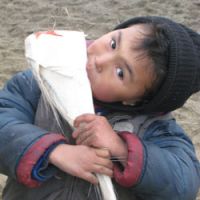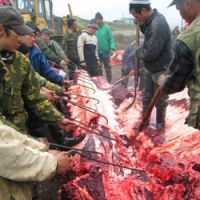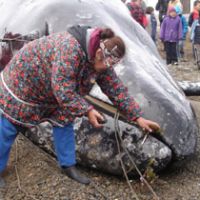CHUKOTKA, Russia — This month, instead of writing this column as usual at my desk in Hokkaido, I am writing from a desk on board the Clipper Odyssey as we cross the Gulf of Anadyr in Russia's far northeastern Chukotka region. Our voyage began at Otaru, Hokkaido, and we have taken in southern Sakhalin, the Kurile Islands, Kamchatka and the coast of Chukotka on our way to Nome, Alaska.
Against a dramatic backdrop of volcanoes, rugged cliffs, ice-sculpted beaches and hardy tundra we have explored abandoned Soviet-era submarine bases and Japanese whaling stations, visited indigenous Chukchi and Inupiak settlements and the one-time resupply town for the Russian Far East Fleet, Provideniya.
Along the way, we have been treated to extraordinary concentrations of wildlife — Tyuleni Island was carpeted with Common Murres; Srednego Rocks teemed with Northern Fur Seals and Steller's Sea Lions; Bogoslov Island was piled up with Walruses — and there have been treats in the shape of a spectacular Orca pod, up to 17 Brown Bears in one day (!), repeated sightings of Minke and Grey whales — and a fabulous list of birds that has included the inspiring Steller's Eagle, the enigmatic Spectacled Eider and the rare Emperor Goose, as well as Siberian Rubythroats, Pechora Pipits and a host of others.
In most respects, this has been a typical series of successful nature-oriented expeditions. In most respects that is, except one.
Visiting the outlying communities of the enormous coutry of Russia is always fun. Visitors are rare, and the welcome is warm — even when the scenery is fog-draped and dominated by rusting remnants of the Cold War military presence, the grimness of Soviet-era concrete or the remnants of collective fox farms.
Color arrived in the remote communities of Chukotka in December 2000 in the form of Gov. Roman Abramovich (of Chelsea F.C. fame), whose tax-dollar projects enlivened it until he resigned on July 3, 2008, delivering Canadian-built Arctic housing, hospitals and schools. The brightness of Canadian-style buildings is in stark contrast to the bleached wood of older construction and that decaying Soviet-era concrete.
Walking around these settlements on the shores of the Bering Sea, you never quite know what to expect next. One constant, though, is the presence of animal bones. These are or have been largely subsistence communities, and with agriculture quite impossible in this Arctic area, subsistence means hunting.
Near Cape Dezhnev, the easternmost point of continental Asia, lies the old settlement of Naukan. It is situated in sight of Ratmanova Island, and beyond it Cape Prince of Wales in Alaska is just 82 km away across the Bering Strait. At Naukan, whale-hunters were able to watch out over the migration route of the enormous Bowhead Whale, waiting for an opportunity to hunt that marine bounty as the pelagic mammals moved with the advancing and retreating sea ice each year. The village was once home to as many as 2,000 people, but it now lies abandoned, along with the nearby and more modern polar meteorological station. Stone-walled pit dwellings, some still partly roofed with enormous whale ribs and jaw bones, testify to the enormous energy that went into the construction of Naukan over generations — energy supplied by the meat and blubber of seals and whales.
A few hundred yards away, an imposing bust of Semyon Ivanovich Dezhnev (1605-73) looks out across these scenes of abandonment toward Alaska. Had Dezhnev's report of his explorations in the 1640s not been buried by Russian bureaucrats, we would now be calling this region Dezhnevia (not Beringia, after Vitus Jonassen Bering [1681-1741], the Danish-born navigator in the service of the Russian Navy), along with the Dezhnev Strait and the Dezhnev Sea, for he was here long before Bering and successfully proved that Asia and America were not connected. Of course the local inhabitants who had sailed these waters for untold centuries in baidara (walrus-hide boats) had always known that, but they were never asked.
Not far away, at Itygran, is further testament to the importance of the Bowhead Whale to the peoples of this region. Variously interpreted as a spiritual location or a communal hunting site, Itygran looks out over a narrow channel toward Arakamchechen Island. Not for nothing is this area known as "whale-bone alley," because there it's impossible to overlook the rows of moldering, lichen-encrusted whale skulls and erect whale jawbones pointing eerily skyward, positioned with some effort for reasons now lost in the mists of time.
While some whaling communities have died out or been relocated, signs of whaling are everywhere. Each year, when I have visited Chukotka I have found fresh signs of a whale hunt — remnants of carcasses, or freshly stripped bones on the beach. For the communities of Yanrakinnot and Lorino, whaling and sealing are still very much a part of the culture, custom and food supply — as they are for communities on St. Lawrence Island, just to the east on the American side. In both, drying-racks groan under loads of wind-drying Salmon, Walrus and Bearded Seal meat, while cold stores and freezers are stocked with whale meat. I once visited an old-style meat store, dug deep into the permafrost, and found it stacked with grisly joints of the dark, almost black flesh of whales.
But as I said, in most respects this has been a typical series of expeditions for me. The one exception was at Lorino. The intensity of the experience was extreme, and in some ways I am still processing what I witnessed there, although it was over in 2 1/2 hours. It has given me much food for thought, if you will excuse the phrase.
Offshore, we had been whale- watching: Grey Whales are common here, and their low, V-shaped blows and the shape of their tail flukes are highly distinctive. In Chukotka, these shallow-water, bottom-feeding cetaceans are at the far northern limit of their migration, having traveled here all the way up the west coast of North America and into the Bering Sea from their calving grounds off Mexico to harvest the benthic bonanza of this rich marine zone.
As we traveled by Zodiac inflatable to visit the village of Lorino, we noticed something in the water tethered to the shore and quickly realized that the village had had a successful hunt that day. In fact it turned out to be their second whale of the day, another part of their annual 47-animal quota allowed under International Whaling Commission agreements.
We had planned to explore the village area on foot. I, for one, had planned to look for birds, but actually few, if any of us, strayed from the spectacle on the beach as a tractor was hitched to a hawser and the whale was hauled ashore. The sleek, aquadynamic shape was fully revealed in a way impossible to appreciate at sea. A brief ceremony was performed, symbolically feeding the whale tundra plants, bread and chocolate, and even proffering a cigarette.
The whale was then measured and recorded for the official record, and flensing began. I have experience of dismembering various game such as rabbit, hare and deer, but this was on a scale I had never previously imagined. First the blubber, then the meat, then the internal organs were all stripped away in a process that involved two skilled men with long-handled flensing knives, a team of pullers with hooks to maintain tension, and ultimately dozens of locals each armed with an ulu knife and a bucket or a bag to take away their portion.
A huge trailer was loaded with the larger pieces to be hauled off for freezing. Some adults were chewing slivers of muktuk (blubber or skin), while children seemed to savor pieces of baleen. I watched as one man excavated the ossicles (ear bones) for later carving, and another scooped out the brains by hand. It would be easy to call it a grisly process, but only because the preparation of meat in our own diets has become so remote and sanitized.
What impressed me was how little was left on the beach at the end of it all — blood stains on the gravel, the skull, some scraps of innards and blubber and the whale was gone.
The ongoing thoughts that having observed that powerful process stimulated in me are perhaps for another occasion.
Mark Brazil is a naturalist and author with a fascination for life in all its forms and the questions that it raises. He leads naturalists and nature-lovers around the world for Zegrahm and Eco-Expeditions. He can be contacted at [email protected]






















With your current subscription plan you can comment on stories. However, before writing your first comment, please create a display name in the Profile section of your subscriber account page.